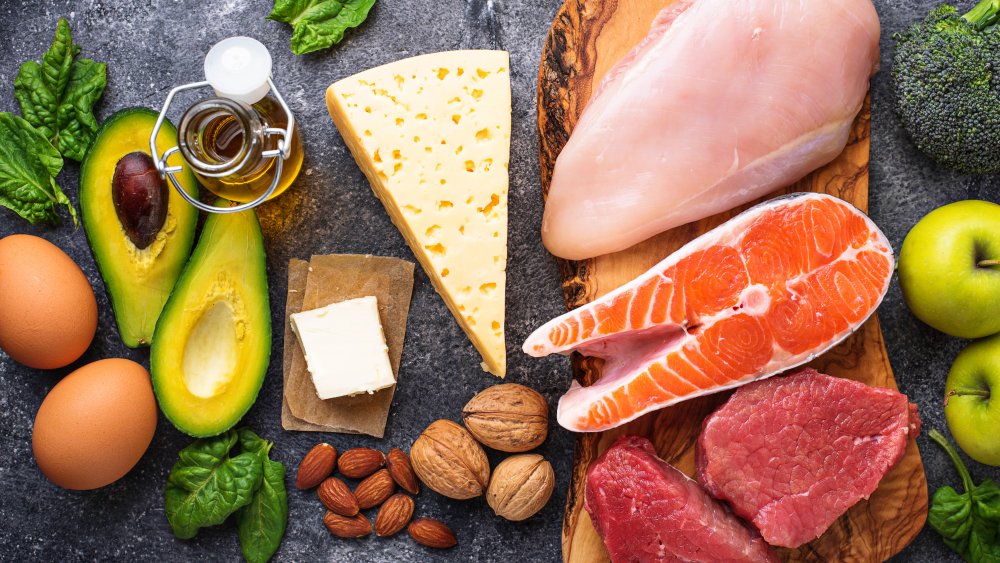The Difference Between Counting Calories And Counting Macros
We've probably all heard that losing weight is about "calories in, calories out." Maybe we've even been told that we can go ahead and enjoy a donut, as long as we spend about a half hour at the gym burning off that gooey Boston creme (per LiveStrong). Indeed, plenty of successful dieters brag about how they've lost weight while eating whatever they want, donuts included; there's the famous story of a high school science teacher who lost 56 pounds while eating only McDonald's for six months, just being careful not to exceed 2,000 calories a day (via Today). But experts have argued that counting calories isn't the best way to achieve and maintain a healthy weight. Instead, some say we should be focusing on macros.
"Macros highlight the balance of your diet and give you a look into what you're eating," Jade Dinsdale, a certified health coach in Florida, told Eat This, Not That! "Calories don't give you balance, they just give you a number. When we are focused too much on counting calories, we often miss our nutritional needs. If we limit ourselves to quantity, we might forfeit quality." While a calorie measures the amount of energy in a food or beverage, a macro, or macronutrient, refers to whether the type of calories you're consuming are from protein, carbohydrates, or fat (per Insider).
How to count macros
If you're thinking that counting macros will give you a break from all the numbers crunching you might have done in the past to count calories, think again. In fact, knowing your macros starts with knowing the number of calories you need to eat to maintain your current weight, and then deciding how much of a calorie deficit will be necessary to lose weight (via Healthline). You can use a simple, free calculator provided by the National Institute of Health to arrive at your numbers. Next, you need to decide what your macronutrient ratio should be — what percentage of your total calories should come from protein, carbs, and fats.
This is where things get complicated. Federal health guidelines suggest getting 45 to 60 percent of your daily calories from carbs, 20 to 35 percent from fats, and the rest from protein (via Cnet). But your goals may change if you're going on the high-fat, low-carb ketogenic diet, which calls for only 5 to 10 percent of calories from carbohydrates and 75 to 80 percent of calories from fats, the rest from protein (per Well + Good). Bodybuilders, meanwhile, might put most of their eggs in the protein basket.
Once you have macro goals figured out, you're going to need to start tracking not only how many calories you eat every day, but what percentage of those calories come from each macro. Apps like My Fitness Pal will help you manage all of this math.
If you're not a numbers cruncher, consider flexible dieting instead
If you were intrigued by the concept of counting macros because it would mean a healthier diet than one focused on just calorie intake, but now feel overwhelmed by the idea of tracking not only the number of calories in that grilled chicken salad you just had, but what percentage of those calories came from carbohydrates, protein, and fat, don't despair. You can still lose weight if you keep your focus on eating high-quality food–getting your carbs from fruit or oatmeal, not Cheetos — and making sure you eat plenty of protein. This concept is called "flexible dieting."
"The overall concept is similar to Weight Watchers in that you can eat what you want as long as you're keeping your calories at a certain level, but with flexible dieting, there's an emphasis on protein," Brad Schoenfeld, Ph.D., director of the Human Performance Lab at CUNY Lehman College in New York, told Men's Health. "The scientific literature is very clear that getting proper amounts of protein is the most important thing to maximize muscle and improve body composition." In fact, a study published in Eating Behaviors found that flexible rather than rigid diets — which is how many would describe trying to meet certain macro goals each day — resulted in greater long-term success at achieving weight loss.



